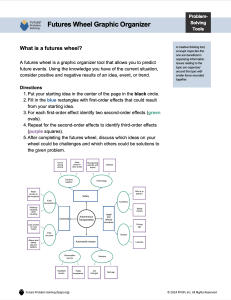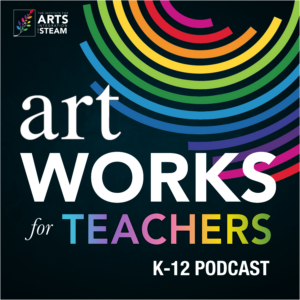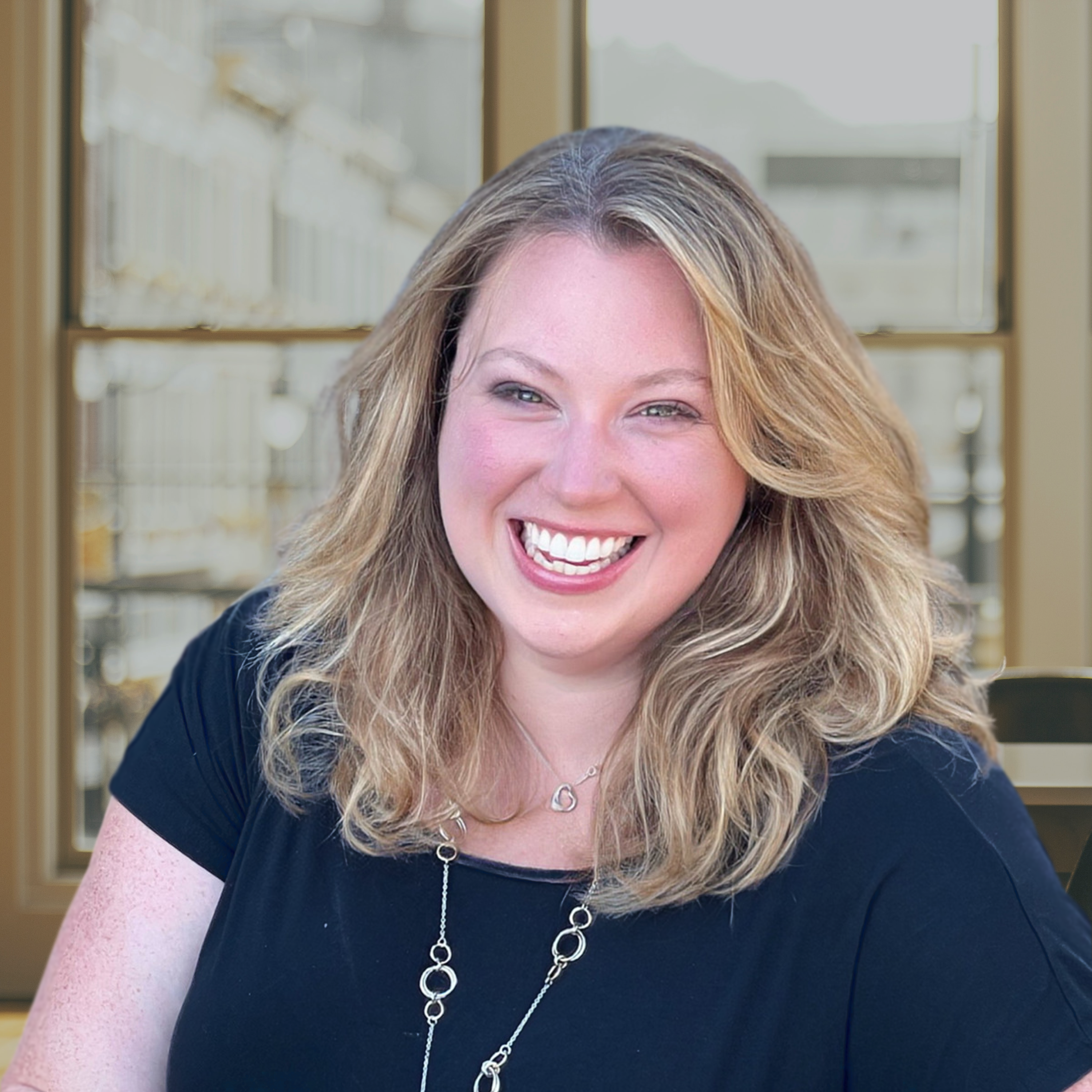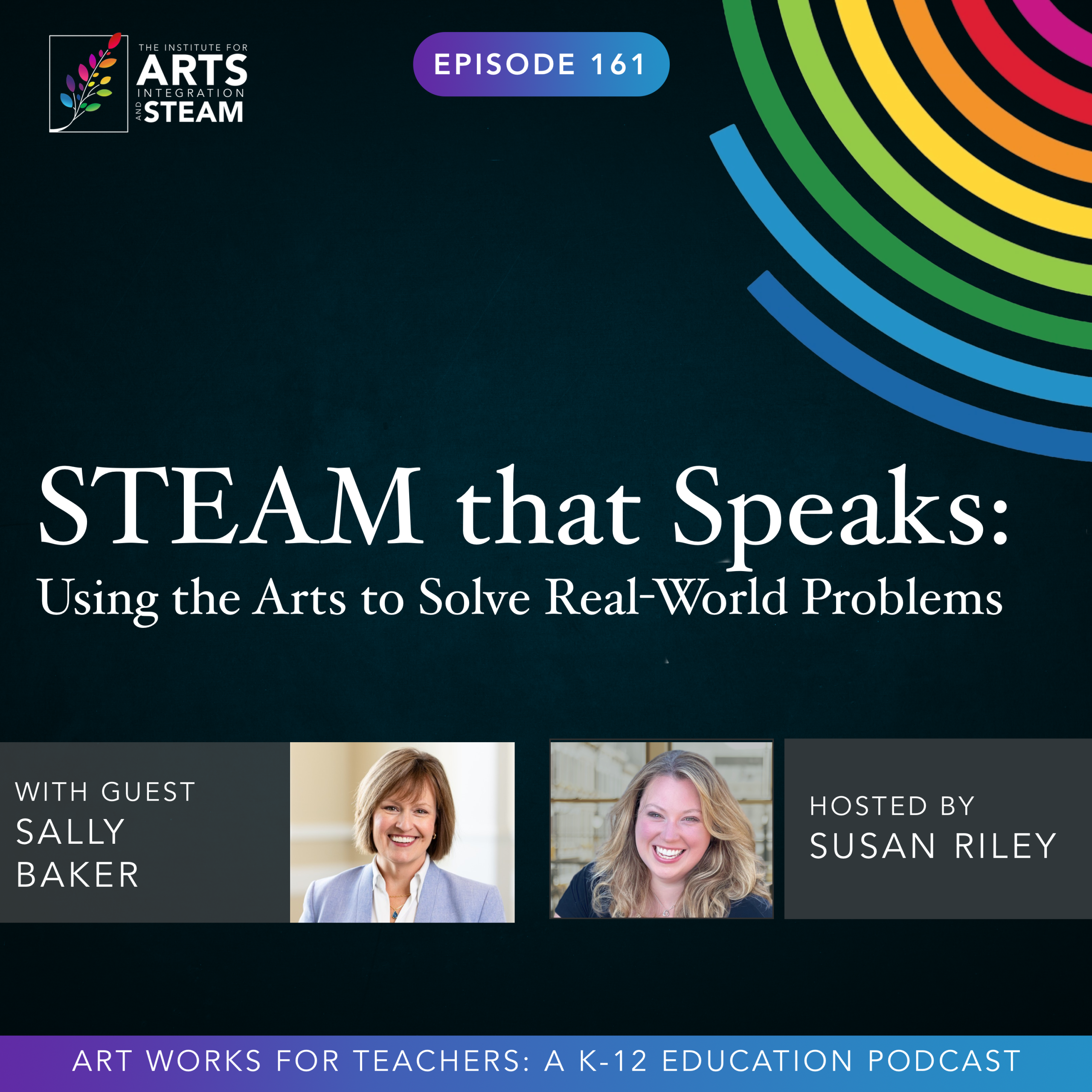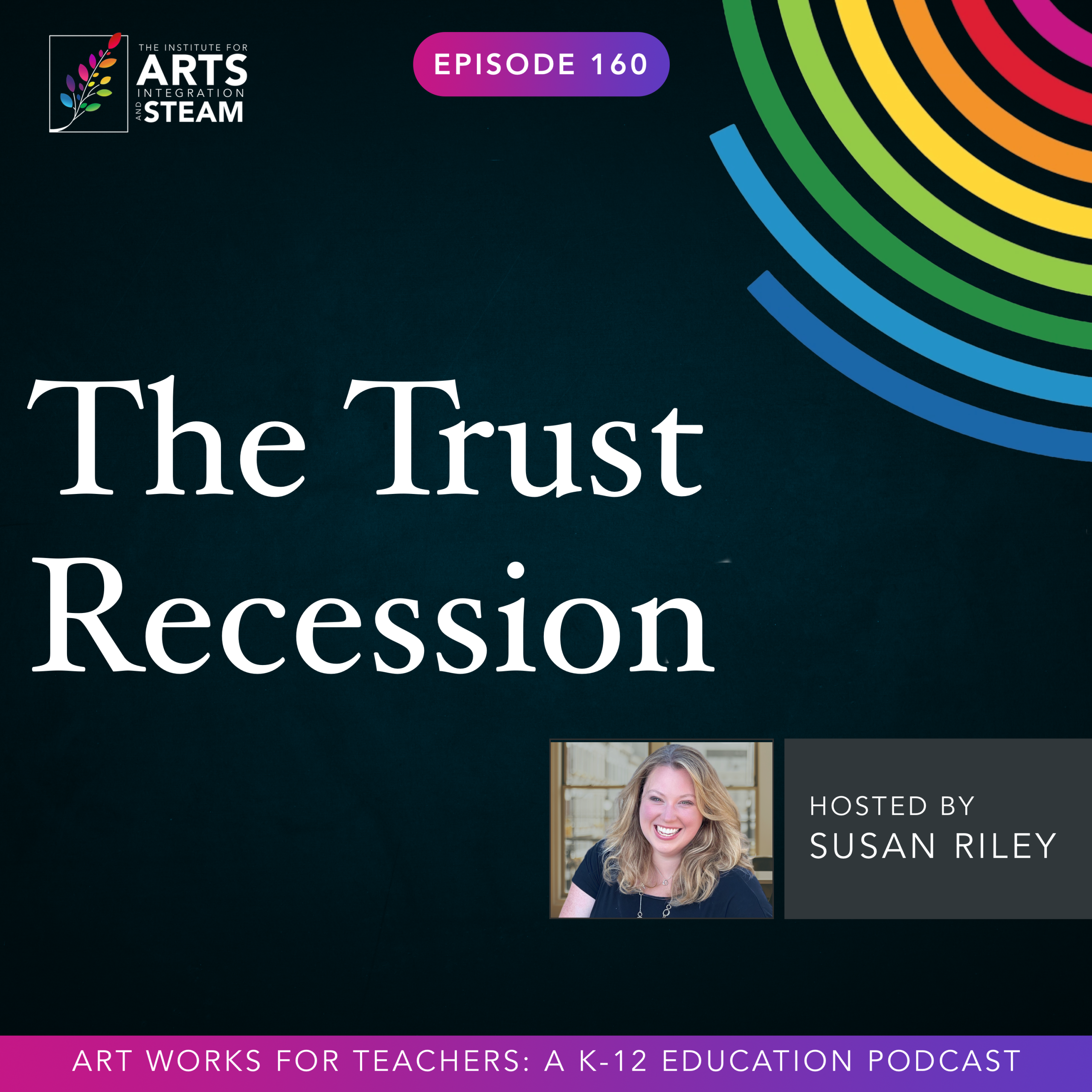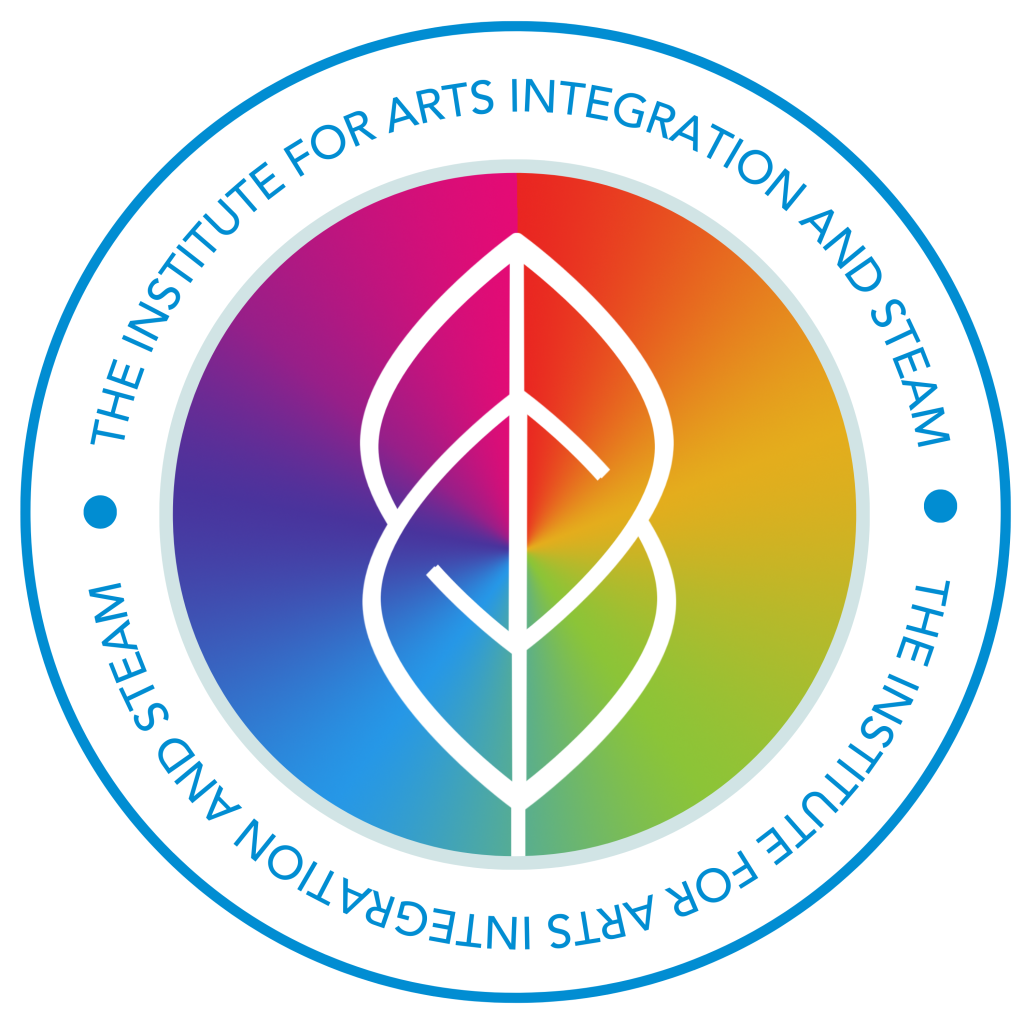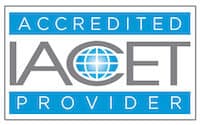ART WORKS FOR TEACHERS PODCAST | EPISODE 149 | 32:45 MIN
Future-Proofing Students: Teaching Creativity for an Uncertain World
Enjoy this free download of the Futures Wheel Graphic Organizer from fpspi.org.
April, it's so great to have you on the show. Thank you so much for joining me.
April
Thank you, Susan, for the invitation. It's lovely to be here and I appreciate everyone who is planning to watch.
Susan
Of course, absolutely. So I know that you're the executive director of future problem solving. I would love to know though, just to get a little background, how did you end up in this position? Like what's your background in education and how did you end up here?
April
Sure. Well, I'll start with the now and sort of go back. So at Future Problem Solving, our mission is teaching kids how to think, not what to think. So I've landed at an organization that really spoke to my heart before I even knew the motto of Future Problem Solving. Looking back, reflecting, it really has been a theme of my entire career in education. As I was preparing for this podcast, I realized it's been nearly 30 years that I've been in public education. So quantifying that was very celebratory, I guess. And I spent more than a decade in the classroom and in leadership roles within my local school district. But my passion was working with advanced learners. Those students who had that intense curiosity, they were always innovating, asking the what if really tough questions and really keeping me on my toes as their teacher. And what I loved most about working with those students was when they reached that aha moment, especially when they pivoted to that knowledge that they were capable of more than they imagined. And a lot of those aha moments were when I was teaching and coaching Future Problem Solving itself. So in the program, we give students the chance to explore really engaging real world issues, but we give them tools and critical and creative thinking. So over time, I started thinking about how I could make that impact on a larger scale. So in 2012, I joined the headquarters staff of future problem solving. And since 2018, I've had the privilege and honor as for serving the organization as the executive director. So now I work with students teachers, educational leaders from all over the world. We're in 14 countries currently, and we equip them with the skills that matter for their life. We like to say we not only hit on the four Cs, but also that fifth C, which is caring.
Susan
Yeah, well, that's super exciting. And I think it's important for people to realize that, and I didn't realize this until I did some research for the show, that future problem solving has been around for 50 years. You guys have been around for a long time.
April
We have, we have. We were developed in 1974 by creativity pioneer Dr. E. Paul Torrance. He realized students weren't thinking about their future. So he used the creative problem solving process that Osborne and Parnes had developed for businesses back in the 50s and adapted that for the use with students.
Susan
Yeah, this is fascinating because in my upcoming book, I actually referenced Torrance quite a bit and how he landed upon his creativity, his creativity scale and what we often use for the Torrance tests for that. I love that that is baked into the organizational foundation as it will. And I know that you guys have international conferences and so many things that are going on and I'm going to get there. But before we do that, I want to go back a little bit. You said that your mission is to teach students how to think, not what to think. And I think this is a huge shift from where many educators are right now or what they have been trained to do, right? Because they've been trained to deliver curriculum. And that's not necessarily their jobs, right? It's to allow students to move beyond that. So you have a six step model that teaches students how to do this, right? Can you walk us through what that model is, like the six steps of that model, and maybe give us an example of what that would look like?
April
Absolutely. So as you mentioned, Torrance is the backbone. You've referenced him in critical and creative thinking. And lots of times when students embark on the program, we teach them how to begin with the end in mind. So teaching them the skills of what's tested on the Torrance test, right? The fluency, flexibility, originality, and elaboration. And they develop those outcomes when they go through the six-step process.
And the six step process ebbs and flows through convergent and divergent thinking. So in step one, after the students have analyzed a situation, they develop challenges. We encourage them to think as broadly as possible. We give them categories, asking them to analyze all sides of the problem. So that's a very, very creative step. One that kids grasp onto and dive into pretty easily. They're innately good at that. The second step of our process, to me, is where the beauty of the six steps really starts to take hold in student learning. They are then asked to analyze their 16 challenges that they've just created and develop an underlying problem. So they now apply that convergent thinking. They take all those ideas and they analyze them. And they determine, the students determine, which one of those challenges has the greatest significance and scope on the problem they're solving, and they develop an underlying problem that frames out the aspect they want to solve. They then move out into creativity again, developing a wide range of possible solutions to solve that problem. Steps four and five of the process, the students themselves develop their criteria to measure the possible solutions, and then they rate their solutions against each other on the criteria that they've developed. In the final step of the process, the students develop an action plan, what kinds of things they would do to actually solve the problem. They might list people that would assist them in solving their problem. They might address various criteria that they develop to choose that winning solution. And they fully develop that out, giving us a vision, a pitch, if you will, of the solution that they've created.
Susan
So this is reminding me a lot of project-based learning. So how do you see this kind of six-step process aligning or perhaps even working and weaving in with project-based learning, which is super popular right now?
April
We have a lot of educators who are in schools or in districts where project-based learning is a priority and an initiative. So future problem solving is just one way to complement that. In PBL, I know a lot of the students are either given the project to work on or asked to select a project of their own and their notice. And that aligns beautifully with our community projects aspect of our offerings.
And that's where the students find a problem in their community and they go through the six steps to solve that. So it's a beautiful compliment.
Susan
Yeah, and I really think based on what you've been sharing so far, it also overlays beautifully with what we call the six-step steam process. That it's the same kind of thing. And I think we're all coming around this same system or idea of how to encourage not only convergent and divergent thinking, which you mentioned, but also that critical lateral thinking that oftentimes gets missed and that is a hallmark of creativity. Why?
What exactly do you think about when you're thinking in terms of creativity? And we know that it is a vital component, right? A vital skill, often undervalued, but still vital. Why do you think that is? Why do you think that we need to emphasize creativity now more than maybe in the past?
April
I see creativity as sort of the engine behind everything we do in problem solving. We can ask students to master content, but in reality, the solutions that they're going to face that we might not even be able to predict right now aren't ready made. They need to be able to approach the thinking differently. Practicing creativity will help them adapt. It will help them navigate uncertainty and imagine possibilities. I don't think it's a nice to have an education. I feel it's essential. It's essential for their future. And quite honestly, it's essential for our future because they're going to be the ones taking care of us. They are the next generation and we truly, we truly need them. One of the things that really pivoted my approach to creativity was working with the advanced and talented students and helping them develop their creative strengths. Because you and I know working with students, if you ask students, something like, how creative are you? They're immediately, most of the time going to think, Picasso is creative. You know, this star and falling on TikTok is creative. I'm not creative. So if we start reframing. There's a lot of work right now on, you know, our mindsets and shifting our thinking. But if we think about our approach and we ask students, how are you creative? It lights that spark to find those things so they can uncover that creativity within them. It's just really that difference, that different lens. Also, creativity can't stand alone.
We talked about the six step process and the need for it balancing with critical thinking. And I think that's where there is a lot of crossover with the arts. To develop a piece of art or a complete artwork, you have to go through refining and selecting ideas to turn that creativity into action. And that's really where the magic happens when the students can take their imagination and move it into impact.
Susan
Absolutely, and I think I want to this line of thinking a little bit just because what I've noticed, especially in the last five years since 2020, this, that's a hallmark for everybody, isn't it? Like hallmarks since 2020. Oh yes, oh yes, I know. And so, and here's what I have found overwhelmingly, that imagination,
April
It is. And those students, by the way, just started kindergarten.
Susan
I know, I know… but what I've seen is that imagination is a struggle for many of our students and it's such a hallmark of creativity itself. Like I would always use the exercise I would, know, simple, take a pencil and I would say, give me five different things that you could use this pencil for. That's not for writing. And before 2020, mean, like, kind of like lightning, you know, everybody, I got this idea, this idea, and they would ping off of each other. And now when I do that, it's oftentimes radio silence for a long time until somebody is brave enough to think like, um, maybe I can put my hair up with it. Like, you know? And then when somebody has a brave thought, but that struggle for imagination, I think that's so indicative of where our society is right now.
And when we talk about future ready, right, which I think gets used a lot right now, it seems to be a big buzzword in education. But from your perspective, what really makes students future ready then?
April
I there's a lot of aspects to that. Certainly as a basic answer, it goes beyond memorizing content. It goes into those unstructured problems and how students either attack or solve those problems. It's their ability to adapt when rules or parameters change suddenly. And also that collaboration piece is vital. The students really need to work effectively with others. When I think about our mission at Future Problem Solving to prepare young people globally to design and achieve positive futures, we have several aspects that encourage the students to really become future ready.
We align with a lot of the United Nations Sustainability Development Goals. And that is amplified in the students' approach to futuristic what-ifs. We used to call our future scenes fuzzies. And, you know, we moved to a more polished word instead of using the word fuzzy situations. But that's truly what it is.
We are preparing kids for a fuzzy situation. We don't know what they're going to see as a problem. They don't know what they're going to see as a problem. So we need to equip them with tools so that they're ready.
Susan
Yeah, and how do you feel like the arts may or may not support those kinds of actual future ready tools?
April
Well, imagination, empathy, persistence. So when you have students working in the arts and they can step into another perspective, they can envision a new possibility and they keep refining their ideas until it works. That develops that, you know, resilience that helps students be prepared for that uncertain future.
It helps students take risks, helps them to iterate their ideas, their creations, and to collaborate and communicate in those powerful ways that are going to translate into real-world problem-solving.
Susan
I love this idea of building resilience and refinement and curating the idea of being able to take a ton of ideas and know what's most important and kind of carve away till you get to the gold, which is so important right now, especially with all of the AI tech that is available. Everything is at your fingertips, right? And I also think with AI being so prevalent and as well as a slew of other tech advancements that are going on every day you turn something on that's, when did that happen? That's revolutionary and that's just like another day, right?
In the midst of all that though, we still have accountability pressures as educators, That there's still these standardized tests that it seems silly, right? Like the future is coming at us at lightning speed and yet we're still doing these things that we were doing 40 years ago which don't seem to really move the needle much. So how do you encourage educators to balance those accountability pressures which are very real with opportunities for creative creativity, collaboration, and deeper problem solving.
April
That's a tough question. That's a tough question for teachers in the classroom, educational leaders, and decision makers because accountability and testing pressures are real. Teachers in the classroom feel that every single day. Administrators and their data teams feel that every day. So I think we need to grab on to small shifts and ask ourselves, you know, within the standards, within the scope and sequence of what I'm with every day with my students. How can I carve out some space for open-ended questions? Where can I infuse collaborative projects into my weekly curriculum? And just sparking those what-if moments, just to help students feel ownership of their ideas, that'll really soar that engagement factor into their classroom and
You know, lots of times these little sparks of creativity and experiences we offer the students will translate into stronger test results. One thing that I experienced when I was in the classroom and I often hear from educators in our program is that the opportunities for deeper problem solving are very valuable for students who have already mastered the basics differentiation, giving those students the experiences that, you know, when they finish something quickly, when they've demonstrated mastery, how can we challenge them? How can we stretch their thinking? And future problem solving is a great solution for that. It gives students a framework to dig deeper, to research the complex real world problems, but then to also share that with their peers in a way that features their thinking.
So it can engage those learners that need that differentiation, deeper dive, but also can enrich the classroom as a whole.
Susan
Yeah, I want to kind of get into the nitty gritty about that a little bit in terms of time. Because I know it's one of the things that is the first pushback that you're going to hear from any educator is especially with this packed of a day as they have, right? Is I don't have time for that or how much time does that take? So if they're working within your framework, how much time does it take? it a long period? Like, are we looking at a unit? Are we looking at a five minute warm up? What are we looking at?
April
So we have a wide range of academic and competitive offerings that can truly be adapted to fit the day. For instance, you mentioned the pencil activity, right? So that's a perfect way to teach students about thinking fluently and flexibility, right? So you have five minutes to line up your class for recess. And you say, when you have an idea of how to use this pencil differently, you can line up for recess. And someone says, use it as a hair tie. Someone says, use it as a skewer for the barbecue grill. Someone else says, put it as a plant stake to label plants in your garden. And you get to that lull, right? And no one else can think of anything. That's when you can start talking about ways to hitchhike and piggyback, which is a cornerstone of creativity. Okay, we had ideas for gardening, we had ideas for cooking, and we had ideas for beauty and fashion. Can anyone else think of a way for beauty and fashion? yes, it can help young kids learn how to tie their shoe, because they'll put the pencil down and help the laces line up. So we can sneak those things in, even in little five minute increments like, you know, lining students up. Or, you know, perhaps you have those learners that if you're doing pre-tests on content mastery and you have students who, you know, demonstrate mastery on a pre-test, is there a reason for those students to go through the scope and sequence of content when they've already demonstrated mastery?
We want those students to stay engaged. So if we were to provide them with research on a topic and with the framework for the six steps, those students could work on that because they've already demonstrated the content, they could have that differentiation activity and really provide them with a way to stay engaged academically.
Susan
I love that. I love that idea so much. And I also think I really enjoy that you focused on advanced learners because so many people don't. We're so focused and I saw this a lot with arts integration, a lot with STEAM. It's one of the things that I would see teachers really focusing in on the middle, raising up the students who really need those, their, you know, this extra support and maybe even focusing on once you get to the middle being able to get everybody. But those advanced learners were often left behind and to the frustration of both the learners and the teachers and the parents, right, to everybody. And I love that this kind of brings them in and gives them a different point of view or a different way of engaging with the same content that you're still teaching with everybody else through that tier one instruction, which I think is so important.
April
We're currently running a topic right now on rising sea levels, very cross with other standards in science, right? So students that might be ready for something different and differentiation being different, right? Not more. We could give them that very similar science strand if that's what worked. So they could work on that, practice those higher order thinking without giving them more work or sometimes it's a case where students access tutors to others and we never want those students to disengage. We want them to keep thinking different and higher order thinking.
Susan
Right, absolutely. So you've seen, I'm sure, countless students go through the future-ready, you know, future problem-solving frameworks and everything in the process. Is there a story of a student or a team whose creative solution has really surprised you in some way that maybe showed you what was possible if you give kids the space to think about things like this?
April
Probably one that has stayed with me for 11, 12 years. We were visiting some schools in New Zealand and there were some schools that had adopted future problem solving school-wide. And we met with a group of students and we sort of interviewed them, asking them about their project that they were working on, how they selected their area of concern, what they wanted to work on within their school. And I think it was the care through problem solving that these students demonstrated. They had a deaf and hard of hearing class within their school. And whenever the alarms would go off, those students were really negatively impacted because they were confused and didn't know how to react because the alarm was sounding and they couldn't hear it. So it caused a lot of stress. So these future problem solvers created a visual alarm and they were learning in their science and technology class all about the Raspberry Pi technology. So they took what they were learning and their content and they applied their critical and creative thinking to develop a visual alarm system and they had the raspberry pies, one for each of the desks for the students who were in the deaf and hard of hearing class. And they installed a small little red light bulb and anytime, and it was connected to the school's alarm system. So anytime the school wide alarm went off, that red bulb went off on the students desk so they could see that. And it just really created an environment of inclusivity.
For all the students, it asked students to think outside their own reference and just really demonstrated how improving the life of their peers and having that empathy and caring could really give back to their school community.
Susan
Like, wow, what a powerful story, right?
April
They were just great kids too. Just so excited and energizing. They've really stuck with me. But like I said, last year at our international conference, we had projects that ran the gamut of reducing vaping to reducing bullying. We always have a lot of projects on environmental impact, pollution, reducing waste and things like that.
And always, always very impressive.
Susan
I love this and I love that it also encourages our students to know that they can make a difference no matter what their age, who they are, what their background, that everybody matters. Everybody matters and everybody can do something which is something that I think sometimes we forget, you know? So I appreciate that as well. So April, for listeners who are inspired, as inspired as I am, by your work and the mission of the Future Problem Solving Group, what's the best way to stay in touch and how to find out more information?
April
They can contact me on LinkedIn. We have a website, fpspi.org. In traditional education fashion, right? Acronyms, alphabet soup. But you can just Google future problem solving. We have a library on YouTube. We're very active on Facebook and Instagram. I'd love to hear from you. We have stories, testimonials from as you mentioned, our 51 years of existence from our alumni. We have introductory resource lessons, ways to get involved. And we have people who partner with us who maybe aren't in the classroom anymore, but they wanna volunteer or they wanna evaluate student work and give back that way. And really the best way is to hear more about our students in action.
They always energize me. It's very contagious. And most importantly, it really gives hope for the future.
Susan
Wonderful. Well, we will put all of those links and all of the ways to contact you in our show notes so that people can make sure that they can get in touch. April, thank you so much for your time today and for sharing such an inspirational mission and vision for our future. I really appreciate it.
April
Thank you and thank you for your work. I was able to learn lots of different things from some of your past podcasts. So I really reciprocate and appreciate what you're doing to further these really important initiatives in education.
Susan
Thank you so much, April. Really appreciate that.

